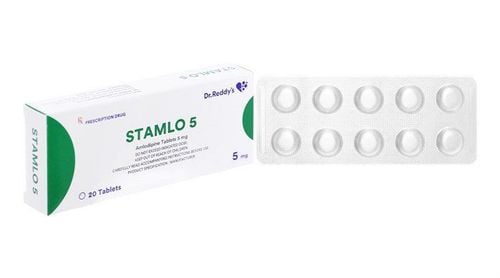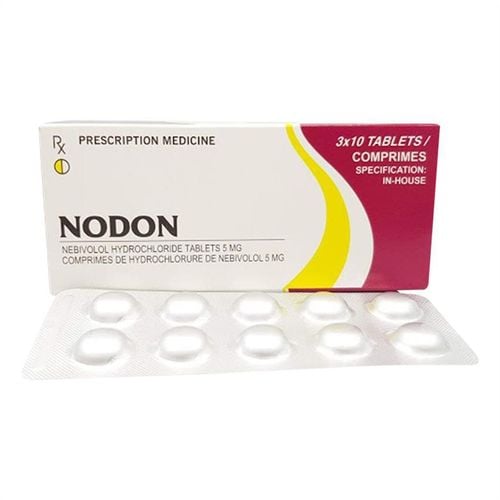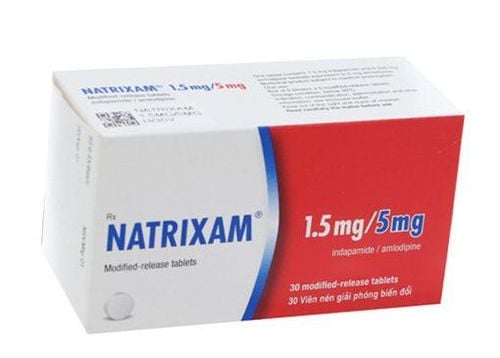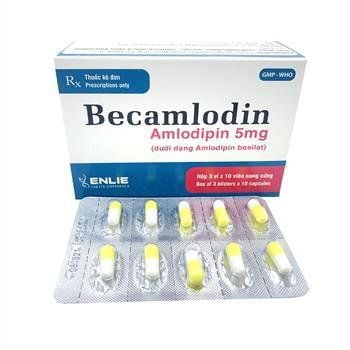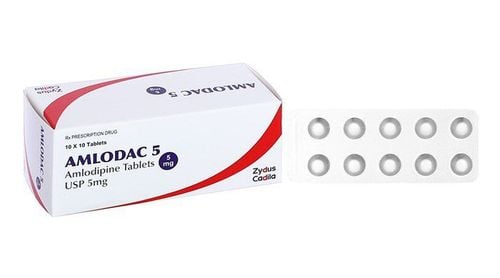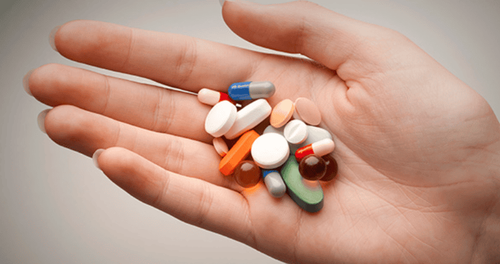This is an automatically translated article.
Dalopin is indicated for the effective treatment of stable angina, myocardial infarction or hypertension. Dalopin will promote the most optimal treatment if the patient takes the drug according to the treatment regimen recommended by the doctor.1. What is Dalopin?
Dalopin belongs to the group of cardiovascular drugs, manufactured by Central Pharmaceutical Joint Stock Company 3 - Vietnam in the form of capsules. Dalopin is used primarily to reverse high blood pressure or stable angina.
Dalopin medicine is packaged in boxes of 3 or 5 blisters x 10 tablets, each capsule contains the main active ingredient, Amlodipine (in the form of Amlodipine besylate) content of 5mg. In addition, the manufacturer also adds some other excipients to increase the effectiveness of the drug.
2. What is the use of Dalopin?
2.1. The effect of the active ingredient Amlodipine
Amlodipine acts as a calcium antagonist of the Dehydropyridine class. This active substance has the ability to block the flow of calcium through the membrane to enter the smooth muscle of the blood vessel wall and heart muscle cells through the mechanism of blocking the slow calcium channels of the cell membrane. Amlodipine helps to reduce the smooth muscle tone of the arterioles, while reducing peripheral resistance associated with hypotension.
Not only that, active ingredient Amlodipine is also used to fight angina. This effect of the drug is due to its ability to dilate peripheral arterioles as well as cardiac afterload. Furthermore, Amlodipine also dilates coronary vessels, thereby providing the oxygen needed by the myocardium in patients with coronary artery spasm.
2.2. Indications and contraindications to the use of Dalopin
Dalopin is used by doctor's prescription to treat the following conditions:
Individual treatment of patients with high blood pressure. In case of necessity, Dalopin can be combined with beta-blockers, thiazide diuretics or ACE inhibitors to increase the effectiveness of treatment. Treatment of vasomotor angina, stable angina and myocardial ischemia. Dalopin monotherapy or in combination with other antianginal drugs, or used in patients unresponsive to beta-blockers or nitrates. However, it is necessary to avoid using Dalopin in the following patients without the approval of a doctor:
Do not use Dalopin for people with a history of allergy or hypersensitivity reaction to the active ingredient Amlodipine or any of the excipients. which drug is in the medicine. Dalopin is contraindicated for children because there are not enough studies to prove the safety of the drug for this population. Dalopin is contraindicated in patients with unstable heart failure. Relative contraindications to the use of Dalopin for pregnant women, people suspected of being pregnant or nursing mothers.
3. Instructions for use and dosage of Dalopin
Dalopin is available in the form of capsules for oral administration. When taking the drug, the patient should swallow the tablet whole, avoid taking it with other drinks such as stimulants, carbonated water, soft drinks or alcohol.Depending on the patient's health condition, the doctor will make recommendations on the appropriate dose, specifically:
Starting dose: Take 5mg/time within 24 hours. Subsequent dose: May be increased to 10mg/time/day. If the patient's symptoms do not improve after about 4 weeks of treatment, the doctor may increase the dose of Dalopin. When co-administered with thiazide diuretics, no dose adjustment of Dalopin is required.
Before treatment with Dalopin, patients should carefully read the instructions for use printed on the product packaging or follow the dosage recommended by the doctor. Absolutely not allowed to buy drugs or adjust the dose of Dalopin without consulting a specialist doctor.
4. How to handle an overdose of Dalopin?
Rarely, intoxication with the active ingredient Amlopidine has occurred. However, a dose of 30g Amlopidine to children < 1.5 years old can cause moderate toxicity. In case of overdose of Dalopin, patients can be generally managed by the following measures:
Monitor the cardiovascular status by electrocardiogram, and at the same time manage the symptoms of overdose on the cardiovascular system. The doctor may give the patient activated charcoal and perform a gastric lavage. In case of need, the doctor will adjust the electrolytes for the patient. For patients with heart block and bradycardia, patients will need 0.5 - 1 mg of Atropin intravenously (adults), or 20 - 50 mcg/kg body weight (children). If necessary, the injection can be repeated. Intravenous drip about 20ml of Gluconate solution (equivalent to 9mg/ml) within 5 minutes. Physicians may consider giving patients additional isoprenaline doses of 0.05 - 0.1 mcg/kg body weight/min or adrenaline doses of 0.05 - 0.3 mcg/kg body weight/min, or dopamine doses of 4 - 5 mcg/kg body weight/min. / minute. Infusion of 0.9% sodium chloride solution to persons with reduced circulating volumes. If necessary, the patient may need a pacemaker. For symptoms of severe hypotension due to Dalopin overdose, the doctor will administer intravenous adrenaline and 0.9% sodium chloride solution. If it is not effective, it is possible to use Amrinon in combination with Isoprenalin.
5. What side effects does Dalopin cause to users?
Here are some adverse symptoms that patients may experience when using Dalopin:
Common side effects: Headache, ankle swelling, dizziness, feeling hot or flushed, weakness , fatigue, palpitations, cramps, abdominal pain, nausea, indigestion or trouble breathing. Uncommon side effects: Tachycardia, excessive hypotension, pruritus, rash, chest pain, bone pain, musculoskeletal pain or sleep disturbance. Rare side effects: gingival hyperplasia, extrasystoles, urticaria, hyperglycemia, increased alkaline phosphatase, increased transaminases, increased lactate dehydrogenase, erythema multiforme or confusion. If any of the above mentioned side effects occur, the patient should stop the treatment and notify the doctor immediately for prompt remedial action. Some adverse events are mild and may disappear when the patient stops taking Dalopin, however, some rare reactions may develop into serious health consequences if treatment is delayed.
6. Some important notes during treatment with Dalopin
During the use of Dalopin, patients should note some general recommendations below to ensure safety and soon get effective:
Caution when using Dalopin for people with aortic stenosis, impaired function liver function or acute myocardial infarction causing heart failure. Caution should be exercised when deciding to increase the dose of Dalopin in elderly patients. The use of calcium channel blockers during pregnancy may inhibit premature uterine contractions. In addition, the risk of hypoxia to the fetus must be taken into account if the drug causes hypotension in the mother, as this can easily lead to placental hypoperfusion. This is considered a common risk when giving pregnant women antihypertensive drugs because they dilate peripheral vessels and cause changes in blood flow. It is best to avoid taking Dalopin during the first 3 months of pregnancy. In the following months of pregnancy, women need to talk with their doctor before deciding to use Dalopin. Although it is not known whether Dalopin accumulates in breast milk, it should be avoided in nursing mothers when the risks outweigh the benefits. A person's reflexes may be impaired as a side effect of the medication, such as headache, dizziness, nausea, or fatigue. Therefore, caution should be exercised when using Dalopin to people who often drive vehicles or machinery. Dalopin has a risk of interacting with other drugs such as anesthetics, lithium drugs, non-steroidal anti-inflammatory drugs or drugs with high protein binding (Hydantoin, Coumarin,...). Patients should inform their physician of a list of all medications they are taking to avoid the risk of adverse drug interactions.




